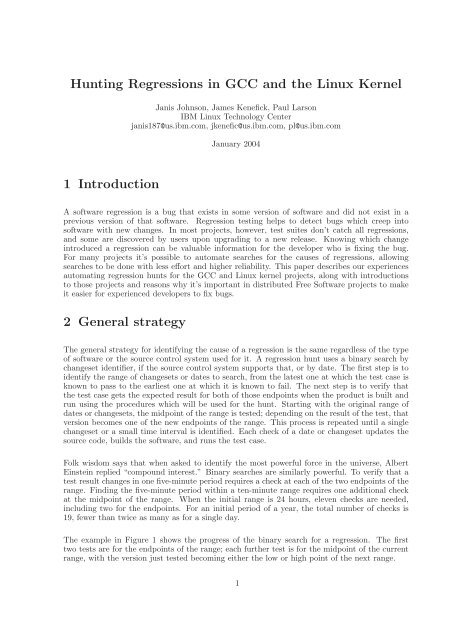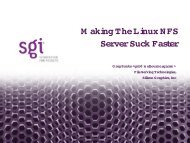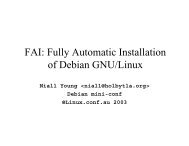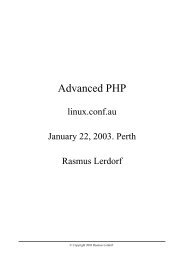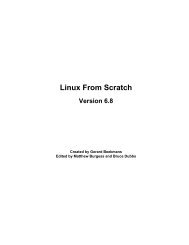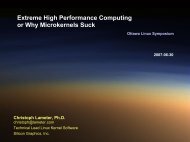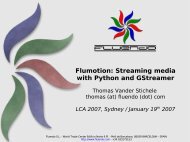Hunting Regressions in GCC and the Linux Kernel 1 ... - mirror
Hunting Regressions in GCC and the Linux Kernel 1 ... - mirror
Hunting Regressions in GCC and the Linux Kernel 1 ... - mirror
You also want an ePaper? Increase the reach of your titles
YUMPU automatically turns print PDFs into web optimized ePapers that Google loves.
<strong>Hunt<strong>in</strong>g</strong> <strong>Regressions</strong> <strong>in</strong> <strong>GCC</strong> <strong>and</strong> <strong>the</strong> L<strong>in</strong>ux <strong>Kernel</strong><br />
1 Introduction<br />
Janis Johnson, James Kenefick, Paul Larson<br />
IBM L<strong>in</strong>ux Technology Center<br />
janis187@us.ibm.com, jkenefic@us.ibm.com, pl@us.ibm.com<br />
January 2004<br />
A software regression is a bug that exists <strong>in</strong> some version of software <strong>and</strong> did not exist <strong>in</strong> a<br />
previous version of that software. Regression test<strong>in</strong>g helps to detect bugs which creep <strong>in</strong>to<br />
software with new changes. In most projects, however, test suites don’t catch all regressions,<br />
<strong>and</strong> some are discovered by users upon upgrad<strong>in</strong>g to a new release. Know<strong>in</strong>g which change<br />
<strong>in</strong>troduced a regression can be valuable <strong>in</strong>formation for <strong>the</strong> developer who is fix<strong>in</strong>g <strong>the</strong> bug.<br />
For many projects it’s possible to automate searches for <strong>the</strong> causes of regressions, allow<strong>in</strong>g<br />
searches to be done with less effort <strong>and</strong> higher reliability. This paper describes our experiences<br />
automat<strong>in</strong>g regression hunts for <strong>the</strong> <strong>GCC</strong> <strong>and</strong> L<strong>in</strong>ux kernel projects, along with <strong>in</strong>troductions<br />
to those projects <strong>and</strong> reasons why it’s important <strong>in</strong> distributed Free Software projects to make<br />
it easier for experienced developers to fix bugs.<br />
2 General strategy<br />
The general strategy for identify<strong>in</strong>g <strong>the</strong> cause of a regression is <strong>the</strong> same regardless of <strong>the</strong> type<br />
of software or <strong>the</strong> source control system used for it. A regression hunt uses a b<strong>in</strong>ary search by<br />
changeset identifier, if <strong>the</strong> source control system supports that, or by date. The first step is to<br />
identify <strong>the</strong> range of changesets or dates to search, from <strong>the</strong> latest one at which <strong>the</strong> test case is<br />
known to pass to <strong>the</strong> earliest one at which it is known to fail. The next step is to verify that<br />
<strong>the</strong> test case gets <strong>the</strong> expected result for both of those endpo<strong>in</strong>ts when <strong>the</strong> product is built <strong>and</strong><br />
run us<strong>in</strong>g <strong>the</strong> procedures which will be used for <strong>the</strong> hunt. Start<strong>in</strong>g with <strong>the</strong> orig<strong>in</strong>al range of<br />
dates or changesets, <strong>the</strong> midpo<strong>in</strong>t of <strong>the</strong> range is tested; depend<strong>in</strong>g on <strong>the</strong> result of <strong>the</strong> test, that<br />
version becomes one of <strong>the</strong> new endpo<strong>in</strong>ts of <strong>the</strong> range. This process is repeated until a s<strong>in</strong>gle<br />
changeset or a small time <strong>in</strong>terval is identified. Each check of a date or changeset updates <strong>the</strong><br />
source code, builds <strong>the</strong> software, <strong>and</strong> runs <strong>the</strong> test case.<br />
Folk wisdom says that when asked to identify <strong>the</strong> most powerful force <strong>in</strong> <strong>the</strong> universe, Albert<br />
E<strong>in</strong>ste<strong>in</strong> replied “compound <strong>in</strong>terest.” B<strong>in</strong>ary searches are similarly powerful. To verify that a<br />
test result changes <strong>in</strong> one five-m<strong>in</strong>ute period requires a check at each of <strong>the</strong> two endpo<strong>in</strong>ts of <strong>the</strong><br />
range. F<strong>in</strong>d<strong>in</strong>g <strong>the</strong> five-m<strong>in</strong>ute period with<strong>in</strong> a ten-m<strong>in</strong>ute range requires one additional check<br />
at <strong>the</strong> midpo<strong>in</strong>t of <strong>the</strong> range. When <strong>the</strong> <strong>in</strong>itial range is 24 hours, eleven checks are needed,<br />
<strong>in</strong>clud<strong>in</strong>g two for <strong>the</strong> endpo<strong>in</strong>ts. For an <strong>in</strong>itial period of a year, <strong>the</strong> total number of checks is<br />
19, fewer than twice as many as for a s<strong>in</strong>gle day.<br />
The example <strong>in</strong> Figure 1 shows <strong>the</strong> progress of <strong>the</strong> b<strong>in</strong>ary search for a regression. The first<br />
two tests are for <strong>the</strong> endpo<strong>in</strong>ts of <strong>the</strong> range; each fur<strong>the</strong>r test is for <strong>the</strong> midpo<strong>in</strong>t of <strong>the</strong> current<br />
range, with <strong>the</strong> version just tested becom<strong>in</strong>g ei<strong>the</strong>r <strong>the</strong> low or high po<strong>in</strong>t of <strong>the</strong> next range.<br />
1
Figure 1<br />
Check<strong>in</strong>g each patch is not practical but, for illustration purposes, if each patch were tested to<br />
f<strong>in</strong>d <strong>the</strong> regression whose search is shown above, <strong>the</strong> results would look like Figure 2:<br />
Figure 2<br />
A search for <strong>the</strong> changeset or time <strong>in</strong>terval for which <strong>the</strong> behavior of a test changes isn’t f<strong>in</strong>ished<br />
until it reaches two adjacent changesets or times with different test results. A search us<strong>in</strong>g<br />
changesets is more balanced than is a search by date, particularly if changesets tend to be added<br />
<strong>in</strong> clumps.<br />
The same strategy can identify <strong>the</strong> fix for a bug that unexpectedly went away. If a bug exists <strong>in</strong><br />
one version of software but not <strong>in</strong> a similar version, such as a different branch or development<br />
tree, <strong>the</strong>n a hunt can identify <strong>the</strong> fix by revers<strong>in</strong>g <strong>the</strong> return code returned by <strong>the</strong> test case. If<br />
<strong>the</strong> code that was modified is similar <strong>in</strong> both versions of <strong>the</strong> software <strong>and</strong> <strong>the</strong> identified patch<br />
doesn’t merely paper over <strong>the</strong> problem, <strong>the</strong>n it can be ported to <strong>the</strong> version <strong>in</strong> which <strong>the</strong> bug<br />
still exists.<br />
The decision about which range to test is more difficult for a centralized project which uses<br />
branches when search<strong>in</strong>g for <strong>the</strong> cause of a bug that exists on one branch <strong>and</strong> does not exist on<br />
ano<strong>the</strong>r. In Figure 3, <strong>the</strong> bug exists on a release branch but not on <strong>the</strong> ma<strong>in</strong>l<strong>in</strong>e, <strong>and</strong> <strong>the</strong>re is a<br />
version with known good test results on <strong>the</strong> ma<strong>in</strong>l<strong>in</strong>e before <strong>the</strong> branchpo<strong>in</strong>t:<br />
2
Figure 3<br />
Test<strong>in</strong>g all changesets for both branches might show that <strong>the</strong> regression was <strong>in</strong>troduced only on<br />
<strong>the</strong> branch, as shown <strong>in</strong> Figure 4:<br />
Figure 4<br />
For ano<strong>the</strong>r bug whose <strong>in</strong>itial <strong>in</strong>formation was identical, test<strong>in</strong>g all changesets for both branches<br />
might show that <strong>the</strong> regression was <strong>in</strong>troduced on <strong>the</strong> ma<strong>in</strong>l<strong>in</strong>e before <strong>the</strong> branchpo<strong>in</strong>t, <strong>and</strong> <strong>the</strong><br />
bug was <strong>the</strong>n fixed on <strong>the</strong> ma<strong>in</strong>l<strong>in</strong>e but not on <strong>the</strong> release branch, as shown <strong>in</strong> Figure 5:<br />
Figure 5<br />
The strategy <strong>in</strong> this case, <strong>the</strong>n, is to test <strong>the</strong> ma<strong>in</strong>l<strong>in</strong>e just before <strong>the</strong> branchpo<strong>in</strong>t to determ<strong>in</strong>e<br />
whe<strong>the</strong>r to perform a full search on <strong>the</strong> branch for a regression, or on <strong>the</strong> ma<strong>in</strong>l<strong>in</strong>e for both a<br />
regression (between <strong>the</strong> lowest date for which <strong>the</strong> test is known to pass <strong>and</strong> <strong>the</strong> branchpo<strong>in</strong>t)<br />
<strong>and</strong> an unexpected fix (between <strong>the</strong> branchpo<strong>in</strong>t <strong>and</strong> a date known to have <strong>the</strong> fix).<br />
Development branches are split off from <strong>the</strong> ma<strong>in</strong>l<strong>in</strong>e sources <strong>and</strong> are later merged back <strong>in</strong>. A<br />
regression hunt on <strong>the</strong> ma<strong>in</strong>l<strong>in</strong>e that identifies <strong>the</strong> merge as <strong>the</strong> cause of <strong>the</strong> regression can be<br />
followed by a new search on <strong>the</strong> development branch to determ<strong>in</strong>e which patch to that branch<br />
caused <strong>the</strong> regression, as <strong>in</strong> Figure 6:<br />
Figure 6<br />
3 Automat<strong>in</strong>g regression hunts<br />
3.1 Requirements for automat<strong>in</strong>g a regression hunt<br />
Basic requirements for automat<strong>in</strong>g a regression search <strong>in</strong>volve <strong>the</strong> source control system, <strong>the</strong><br />
product build, <strong>and</strong> <strong>the</strong> test case.<br />
3
The source control tools must allow access to all source files as <strong>the</strong>y were on a particular date<br />
or when a particular changeset was added. If <strong>the</strong> project uses multiple branches of <strong>the</strong> sources,<br />
<strong>the</strong>n search<strong>in</strong>g for a regression on a branch requires access<strong>in</strong>g <strong>the</strong> sources on that branch as<br />
of a particular date or changeset addition. This is easier if <strong>the</strong> source control system operates<br />
on changesets ra<strong>the</strong>r than changes to <strong>in</strong>dividual files, but it’s sufficient to be able to determ<strong>in</strong>e<br />
which files were modified for <strong>the</strong> same change even if that <strong>in</strong>formation is not built <strong>in</strong>to <strong>the</strong> tools.<br />
The search for <strong>the</strong> cause of a regression <strong>in</strong>volves access<strong>in</strong>g many sets of sources, so it must be<br />
possible to obta<strong>in</strong> each version without adversely affect<strong>in</strong>g <strong>the</strong> productivity of o<strong>the</strong>r people who<br />
use <strong>the</strong> same source repository.<br />
Automated regression hunts are possible only if <strong>the</strong> product build is automated <strong>and</strong> can be<br />
performed <strong>in</strong> a reasonable amount of time. For a particular regression, a hunt is possible only<br />
if <strong>the</strong>re is a test case that fails when <strong>the</strong> bug is present <strong>and</strong> passes when it is not. Additionally,<br />
that test case must be automated, self-conta<strong>in</strong>ed, reasonably quick, <strong>and</strong> safe to run so that it<br />
won’t corrupt <strong>the</strong> test system. A regression hunt also requires access to a test system on which<br />
<strong>the</strong> failure can be reproduced.<br />
3.2 Short cuts<br />
Short cuts are often available to reduce <strong>the</strong> time needed for a regression hunt. When <strong>the</strong><br />
rema<strong>in</strong><strong>in</strong>g <strong>in</strong>terval is small it’s often possible to look through descriptions of <strong>the</strong> changesets that<br />
were added dur<strong>in</strong>g that period <strong>and</strong> identify <strong>the</strong> one most likely to have caused <strong>the</strong> regression,<br />
<strong>and</strong> <strong>the</strong>n test <strong>the</strong> software just before <strong>and</strong> just after that changeset was added. If <strong>the</strong> guess was<br />
wrong, <strong>the</strong> hunt can cont<strong>in</strong>ue with that date or changeset as one of <strong>the</strong> endpo<strong>in</strong>ts.<br />
A hunt based on dates can recognize when <strong>the</strong>re have been no changes to <strong>the</strong> sources between<br />
<strong>the</strong> new date <strong>and</strong> one of <strong>the</strong> current endpo<strong>in</strong>ts of <strong>the</strong> range, <strong>and</strong> <strong>the</strong>n skip <strong>the</strong> test for that date<br />
<strong>and</strong> simply make it one of <strong>the</strong> endpo<strong>in</strong>ts.<br />
For some source control systems it’s possible to make a local copy of <strong>the</strong> repository to avoid<br />
or lessen network overhead <strong>and</strong> to leave out portions that are not needed for <strong>the</strong> hunt, fur<strong>the</strong>r<br />
speed<strong>in</strong>g up <strong>the</strong> process of obta<strong>in</strong><strong>in</strong>g a particular version of <strong>the</strong> sources.<br />
The build of <strong>the</strong> product need not be a complete build; it is sufficient to produce only <strong>the</strong><br />
components that are needed to run <strong>the</strong> test. Depend<strong>in</strong>g on <strong>the</strong> build process it might be possible<br />
to use <strong>in</strong>cremental builds ra<strong>the</strong>r than start<strong>in</strong>g from scratch each time when <strong>the</strong> rema<strong>in</strong><strong>in</strong>g search<br />
range is small <strong>and</strong> <strong>the</strong> current build uses a later version of sources than <strong>the</strong> previous build.<br />
Some short cuts are successful most of <strong>the</strong> time but fail occasionally, such as <strong>in</strong>cremental builds<br />
if not all dependencies are identified correctly. A hunt can try a short cut <strong>and</strong> <strong>the</strong>n fall back to<br />
<strong>the</strong> normal procedure if <strong>the</strong> short cut fails.<br />
If <strong>the</strong> endpo<strong>in</strong>ts of <strong>the</strong> <strong>in</strong>itial range are not known, it’s better to start with a range that is<br />
too large ra<strong>the</strong>r than one that is as small as possible, s<strong>in</strong>ce an <strong>in</strong>correct guess at a small range<br />
requires additional work by <strong>the</strong> regression hunter, while doubl<strong>in</strong>g <strong>the</strong> <strong>in</strong>itial range requires only<br />
one additional check.<br />
3.3 Benefits of automation<br />
After <strong>the</strong> steps of obta<strong>in</strong><strong>in</strong>g a specific set of source code, build<strong>in</strong>g a subset of <strong>the</strong> product, <strong>and</strong><br />
runn<strong>in</strong>g a test are automated, <strong>the</strong> tools to perform those steps can be used <strong>in</strong> a fully automated<br />
4
egression hunt. The first few hunts generally require adjustments to those tools, but once <strong>the</strong>y<br />
are stable <strong>the</strong> <strong>in</strong>cremental time required to set up additional hunts is fairly low. The actual<br />
work of an automated regression hunt consists of sett<strong>in</strong>g up <strong>the</strong> test case <strong>and</strong> a script to build<br />
<strong>the</strong> right subset of <strong>the</strong> project, select<strong>in</strong>g an <strong>in</strong>itial range of dates or changesets, verify<strong>in</strong>g that<br />
<strong>the</strong> hunt reports <strong>the</strong> expected results for those <strong>in</strong>itial dates, monitor<strong>in</strong>g results occasionally to<br />
detect problems that require manual <strong>in</strong>tervention, <strong>and</strong> <strong>the</strong>n exam<strong>in</strong><strong>in</strong>g <strong>and</strong> report<strong>in</strong>g <strong>the</strong> results<br />
at <strong>the</strong> end.<br />
Perform<strong>in</strong>g a regression hunt manually is error-prone. If <strong>the</strong>re is a time lag between steps, <strong>the</strong><br />
person perform<strong>in</strong>g <strong>the</strong> hunt can be distracted by o<strong>the</strong>r tasks <strong>and</strong> get confused about what is<br />
be<strong>in</strong>g tested <strong>in</strong> each step. An automated hunt whose tools create log files which record what is<br />
done at each step makes it easier to check back on what was done <strong>and</strong> recognize mistakes, as<br />
well as reduce opportunities for careless human error dur<strong>in</strong>g <strong>the</strong> hunt itself.<br />
Personal experience has shown that <strong>in</strong>correctly identify<strong>in</strong>g <strong>the</strong> cause of a regression can be<br />
embarrass<strong>in</strong>g, <strong>and</strong> might even lead to bad haiku:<br />
Where’s <strong>the</strong> regression?<br />
I thought it was located;<br />
alas, I was wrong.<br />
3.4 Manual <strong>in</strong>tervention<br />
Several problems that require manual <strong>in</strong>tervention can arise dur<strong>in</strong>g an automated regression<br />
hunt. Mistakes <strong>in</strong> sett<strong>in</strong>g up configuration files or test scripts can cause test results to be<br />
reported <strong>in</strong>correctly, which makes it doubly important to beg<strong>in</strong> <strong>the</strong> hunt by verify<strong>in</strong>g <strong>the</strong> results<br />
for <strong>the</strong> orig<strong>in</strong>al endpo<strong>in</strong>ts of <strong>the</strong> range, <strong>in</strong>clud<strong>in</strong>g exam<strong>in</strong>ation of test output to verify that a<br />
test failed for <strong>the</strong> expected reason <strong>and</strong> not because <strong>the</strong> test was set up <strong>in</strong>correctly. There might<br />
be dates or changesets for which <strong>the</strong> product doesn’t build; this is frequently <strong>the</strong> case <strong>in</strong> <strong>the</strong><br />
<strong>GCC</strong> <strong>and</strong> L<strong>in</strong>ux kernel projects, both of which support a wide variety of configurations, not all<br />
of which are tested frequently. Sometimes <strong>the</strong> test output changes due to modifications that<br />
have noth<strong>in</strong>g to do with <strong>the</strong> bug, such as changes to messages that <strong>the</strong> test script exam<strong>in</strong>es.<br />
The build process might have changed over time, requir<strong>in</strong>g different scripts to perform <strong>the</strong> build<br />
for different versions of <strong>the</strong> source. Tests for an operat<strong>in</strong>g system kernel can encounter a wide<br />
variety of unexpected problems.<br />
3.5 Verification of results <strong>and</strong> <strong>in</strong>termittent failures<br />
If an automated regression hunt uses any k<strong>in</strong>d of short cuts or makes assumptions that are<br />
not always true, <strong>the</strong>n it’s a good idea to verify that <strong>the</strong> bug does not yet exist just before <strong>the</strong><br />
identified changeset <strong>and</strong> that it does exist after that changeset was added. It’s important to<br />
exam<strong>in</strong>e <strong>the</strong> identified changeset to see if it makes sense for it to have caused <strong>the</strong> bug; if not, <strong>the</strong><br />
bug might be <strong>in</strong>termittent. A b<strong>in</strong>ary search for 1 or 0 will always converge, whe<strong>the</strong>r <strong>the</strong> results<br />
make sense or not. Figure 7 shows what it would look like to test all changesets <strong>in</strong> a range<br />
which conta<strong>in</strong>s a normal regression, followed by what it might look like to test all changesets <strong>in</strong><br />
a similar range which conta<strong>in</strong>s an <strong>in</strong>termittent bug. The checks <strong>and</strong> results for a b<strong>in</strong>ary search<br />
which could match ei<strong>the</strong>r of those patterns (this is <strong>the</strong> same b<strong>in</strong>ary search which was illustrated<br />
earlier).<br />
5
Figure 7<br />
Test<strong>in</strong>g at regular <strong>in</strong>tervals can show whe<strong>the</strong>r a failure is <strong>in</strong>termittent, depend<strong>in</strong>g on how often<br />
it fails <strong>and</strong> whe<strong>the</strong>r <strong>the</strong> periodic test<strong>in</strong>g is lucky <strong>and</strong> shows <strong>the</strong> irregularity of <strong>the</strong> results. In<br />
Figure 8, <strong>the</strong> first set of periodic checks uses a large <strong>in</strong>terval that happens to show <strong>the</strong> same<br />
pattern as would be seen for a regression, while <strong>the</strong> two sets of checks with smaller <strong>in</strong>tervals<br />
demonstrate <strong>the</strong> <strong>in</strong>termittent failures:<br />
Figure 8<br />
Some tests might get different results when run multiple times <strong>in</strong> <strong>the</strong> same environment. For<br />
those tests, a check of a particular version can run <strong>the</strong> test multiple times <strong>and</strong> report it as fail<strong>in</strong>g<br />
if any of <strong>the</strong> runs fail.<br />
4 <strong>Hunt<strong>in</strong>g</strong> regressions <strong>in</strong> <strong>GCC</strong><br />
4.1 The <strong>GCC</strong> project<br />
The work described here was first performed with<strong>in</strong> <strong>the</strong> <strong>GCC</strong> (GNU Compiler Collection)<br />
project. <strong>GCC</strong> is part of <strong>the</strong> GNU Project, which is Free Software covered by <strong>the</strong> GNU General<br />
Public License, with copyrights held by <strong>the</strong> Free Software Foundation [1]. <strong>GCC</strong> <strong>in</strong>cludes compilers<br />
for C, C++, Fortran 77, Java(TM), Objective-C, <strong>and</strong> Ada, <strong>and</strong> supports a wide variety<br />
of processors <strong>and</strong> several operat<strong>in</strong>g systems, <strong>in</strong>clud<strong>in</strong>g embedded systems. <strong>GCC</strong> is <strong>the</strong> primary<br />
compiler used for GNU/L<strong>in</strong>ux <strong>and</strong> o<strong>the</strong>r Free Software <strong>and</strong> open source operat<strong>in</strong>g systems <strong>and</strong><br />
is <strong>the</strong> system compiler for Mac OS X. As an example of <strong>the</strong> variety of targets <strong>GCC</strong> supports,<br />
<strong>in</strong> <strong>the</strong> first two weeks after <strong>the</strong> release of <strong>GCC</strong> 3.3 <strong>the</strong>re were reports of successful native builds<br />
for 27 unique targets, with a comb<strong>in</strong>ation of 16 processors <strong>and</strong> 10 operat<strong>in</strong>g systems [2].<br />
<strong>GCC</strong> is developed <strong>and</strong> ma<strong>in</strong>ta<strong>in</strong>ed by a large number of contributors who are ei<strong>the</strong>r volunteers<br />
perform<strong>in</strong>g <strong>the</strong> work on <strong>the</strong>ir own time or people whose work on <strong>GCC</strong> is funded by <strong>the</strong>ir employers<br />
or through contracts. Twelve global ma<strong>in</strong>ta<strong>in</strong>ers can make or approve changes to any<br />
part of <strong>the</strong> project, a few dozen additional ma<strong>in</strong>ta<strong>in</strong>ers can make or approve changes to specific<br />
parts of <strong>the</strong> project, <strong>and</strong> ano<strong>the</strong>r hundred or so people have write access to <strong>the</strong> sources, allow<strong>in</strong>g<br />
<strong>the</strong>m to check <strong>in</strong> <strong>the</strong>ir changes after approval by a ma<strong>in</strong>ta<strong>in</strong>er. Many o<strong>the</strong>r people contribute<br />
but are not able to check <strong>in</strong> <strong>the</strong>ir patches <strong>the</strong>mselves. This development model can be very<br />
6
surpris<strong>in</strong>g to people who have not been exposed to it, but it has been successful for many Free<br />
Software <strong>and</strong> open source projects [3].<br />
<strong>GCC</strong> contributors tend to focus primarily on current development; volunteers work <strong>in</strong> areas<br />
that are of personal <strong>in</strong>terest to <strong>the</strong>m, <strong>and</strong> funded contributors do work that is a priority to <strong>the</strong>ir<br />
employers. Stabiliz<strong>in</strong>g an upcom<strong>in</strong>g release receives adequate attention, but fix<strong>in</strong>g regressions<br />
for bug-fix releases is not a particularly popular activity. <strong>GCC</strong>’s Release Manager can encourage<br />
contributors to fix bugs but has no real authority over <strong>the</strong>m; from his perspective <strong>the</strong>y are all<br />
volunteers.<br />
<strong>GCC</strong> is a large, complex project [4], <strong>and</strong> many <strong>GCC</strong> bugs can only be fixed by an expert who<br />
has a deep underst<strong>and</strong><strong>in</strong>g of <strong>the</strong> <strong>in</strong>teractions between <strong>the</strong> various parts of <strong>the</strong> compiler, which<br />
is usually ga<strong>in</strong>ed through of years of experience. O<strong>the</strong>r contributors who want to help get bugs<br />
fixed can often provide <strong>the</strong> most support by provid<strong>in</strong>g <strong>in</strong>formation <strong>and</strong> analysis that will make<br />
it easier for <strong>the</strong> experts to fix bugs.<br />
4.2 <strong>GCC</strong> processes<br />
4.2.1 Source control<br />
The <strong>GCC</strong> project uses centralized source control us<strong>in</strong>g CVS [5]. CVS h<strong>and</strong>les changes to <strong>in</strong>dividual<br />
files ra<strong>the</strong>r than changesets that modify a set of files. A CVS commit of several files is<br />
not atomic, although it does support provid<strong>in</strong>g a list of files that are usually checked <strong>in</strong> with<strong>in</strong><br />
a very short period of time. By convention, each <strong>GCC</strong> patch is described <strong>in</strong> a ChangeLog entry<br />
that lists all of <strong>the</strong> files that are modified for that patch; <strong>the</strong> same <strong>in</strong>formation is <strong>in</strong>cluded <strong>in</strong> <strong>the</strong><br />
CVS log of each of those files. These conventions allow a human be<strong>in</strong>g to recognize changesets<br />
even though automated tools only know about changes to <strong>in</strong>dividual files.<br />
CVS supports multiple branches <strong>in</strong> a s<strong>in</strong>gle source tree, <strong>and</strong> <strong>the</strong> <strong>GCC</strong> source tree <strong>in</strong>cludes several<br />
branches. The ma<strong>in</strong>l<strong>in</strong>e development branch is used for new functionality that is ready for use<br />
by <strong>the</strong> <strong>GCC</strong> development community. A major release gets a branch when all new functionality<br />
for that release is <strong>in</strong> <strong>the</strong> ma<strong>in</strong>l<strong>in</strong>e <strong>and</strong> is relatively stable; that branch cont<strong>in</strong>ues to be used for<br />
later bug-fix releases. Experimental work is often performed on a development branch which<br />
is merged back <strong>in</strong>to <strong>the</strong> ma<strong>in</strong>l<strong>in</strong>e when it is stable. CVS tools support automated merges of<br />
ma<strong>in</strong>l<strong>in</strong>e changes <strong>in</strong>to a branch, <strong>and</strong> <strong>GCC</strong> development branches generally get regular merges<br />
from <strong>the</strong> ma<strong>in</strong>l<strong>in</strong>e.<br />
Figure 9 shows <strong>the</strong> ma<strong>in</strong>l<strong>in</strong>e, release branches, <strong>and</strong> representative development branches of <strong>the</strong><br />
FSF <strong>GCC</strong> CVS tree between January 2001 <strong>and</strong> June 2003. The branches shown above ma<strong>in</strong>l<strong>in</strong>e<br />
are release branches, with ’*’ show<strong>in</strong>g a release. The branch for 3.2 releases is unusual <strong>in</strong> that<br />
it is actually a cont<strong>in</strong>uation of <strong>the</strong> 3.1 branch. Branches shown below ma<strong>in</strong>l<strong>in</strong>e are development<br />
branches that were merged back <strong>in</strong>to ma<strong>in</strong>l<strong>in</strong>e. Dur<strong>in</strong>g this time <strong>the</strong>re were several additional<br />
development branches that are not shown here.<br />
7
Figure 9<br />
4.2.2 Development process <strong>and</strong> regressions<br />
The <strong>GCC</strong> development process [6] specifies that bug-fix releases only fix regressions. This makes<br />
it important to identify which bugs are regressions so that <strong>the</strong>y will be fixed <strong>in</strong> a bug-fix release.<br />
When a patch to <strong>the</strong> ma<strong>in</strong>l<strong>in</strong>e causes a significant regression, such as a build failure on a major<br />
platform, that patch must be reverted if <strong>the</strong> regression is not fixed with<strong>in</strong> 48 hours. Often <strong>the</strong><br />
cause of a new failure is not obvious <strong>and</strong> must be hunted down.<br />
4.2.3 Bug track<strong>in</strong>g<br />
<strong>GCC</strong>’s bug track<strong>in</strong>g system is available for anyone to view via <strong>the</strong> <strong>GCC</strong> home page, <strong>and</strong> anyone<br />
can submit a problem report aga<strong>in</strong>st <strong>the</strong> FSF <strong>GCC</strong> sources. The <strong>in</strong>structions for report<strong>in</strong>g a<br />
bug [7] specify that a problem report must be accompanied by a self-conta<strong>in</strong>ed test case <strong>and</strong><br />
enough <strong>in</strong>formation about <strong>the</strong> software environment to allow <strong>GCC</strong> contributors to reproduce<br />
<strong>the</strong> problem.<br />
Problem reports are analyzed by volunteers. Currently <strong>the</strong>re is a dedicated group of volunteer<br />
“bug masters” who do this very quickly. A volunteer determ<strong>in</strong>es whe<strong>the</strong>r a bug report is valid<br />
(is not based on a mis<strong>in</strong>terpretation of <strong>the</strong> rules of <strong>the</strong> language or some o<strong>the</strong>r user error). He or<br />
she <strong>the</strong>n determ<strong>in</strong>es whe<strong>the</strong>r <strong>the</strong> bug still exists on active branches <strong>and</strong> whe<strong>the</strong>r it is a regression<br />
from a released version of <strong>GCC</strong>. Some of <strong>the</strong>se volunteers provide m<strong>in</strong>imized versions of <strong>the</strong> test<br />
cases that are submitted with <strong>the</strong> problem reports; it’s not unusual for a talented bug m<strong>in</strong>imizer<br />
to cut down a 30,000-l<strong>in</strong>e test case to 10 or fewer l<strong>in</strong>es of code that trigger <strong>the</strong> same compiler<br />
bug. In addition to be<strong>in</strong>g extremely valuable to <strong>the</strong> people who fix bugs, <strong>the</strong>se m<strong>in</strong>imized test<br />
cases can be used <strong>in</strong> regression hunts.<br />
4.3 Types of compiler bugs<br />
Compiler bugs come <strong>in</strong> a wide assortment of flavors: <strong>in</strong>correct code generation caus<strong>in</strong>g <strong>the</strong><br />
compiled test case to abort or to produce <strong>in</strong>correct output; <strong>in</strong>ternal compiler errors for valid<br />
or <strong>in</strong>valid source code <strong>in</strong>put; an undetected error or miss<strong>in</strong>g warn<strong>in</strong>g, or an <strong>in</strong>correct error<br />
or warn<strong>in</strong>g message. Each of <strong>the</strong>se requires a source file to compile, perhaps a specific set of<br />
compiler options, <strong>and</strong> a test script which recognizes whe<strong>the</strong>r or not <strong>the</strong> test case was compiled<br />
correctly.<br />
8
4.4 Tools for hunt<strong>in</strong>g regressions <strong>in</strong> <strong>GCC</strong><br />
<strong>GCC</strong> contributors have been identify<strong>in</strong>g <strong>the</strong> causes of regressions for a long time, but until<br />
recently <strong>the</strong> methodology was not described <strong>and</strong> <strong>the</strong>re was uncerta<strong>in</strong>ty about whe<strong>the</strong>r it was<br />
even possible to obta<strong>in</strong> <strong>the</strong> sources from a CVS branch for a particular date. In December 2002<br />
<strong>the</strong>re was a big push among <strong>the</strong> “bug masters” to m<strong>in</strong>imize test cases, determ<strong>in</strong>e which bugs<br />
were regressions, <strong>and</strong> <strong>in</strong> general provide as much useful <strong>in</strong>formation as possible to <strong>the</strong> people<br />
with enough experience to actually fix <strong>the</strong> bugs. There was a concerted effort at that time to<br />
identify <strong>the</strong> causes of regressions, <strong>and</strong> <strong>the</strong> people <strong>in</strong>volved agreed to share tips <strong>and</strong> to document<br />
<strong>the</strong>m [8]. Dur<strong>in</strong>g this effort it became apparent that it is possible to automate regression hunts.<br />
A shell script called reg_search was developed at that time to provide <strong>the</strong> framework for<br />
automated regression hunts. Most <strong>GCC</strong> developers prefer to use <strong>the</strong>ir own scripts to obta<strong>in</strong><br />
sources <strong>and</strong> to build <strong>GCC</strong>, so reg_search <strong>in</strong>vokes separate tools to perform those functions.<br />
The various k<strong>in</strong>ds of compiler bugs require different k<strong>in</strong>ds of tests, so <strong>the</strong> script that runs a<br />
particular test merely returns a value of 1 if <strong>the</strong> search should cont<strong>in</strong>ue with later dates, or a<br />
value of 0 to search earlier dates. A configuration file specifies <strong>the</strong> locations of <strong>the</strong>se scripts,<br />
plus <strong>the</strong> low <strong>and</strong> high dates of <strong>the</strong> range to search <strong>and</strong> <strong>the</strong> desired length of <strong>the</strong> f<strong>in</strong>al period to<br />
report (5 m<strong>in</strong>utes by default).<br />
<strong>GCC</strong> runs on systems where o<strong>the</strong>r GNU tools are ei<strong>the</strong>r available by default or are easy to build<br />
<strong>and</strong> <strong>in</strong>stall, so reg_search takes advantage of a nonst<strong>and</strong>ard extension to GNU date to format<br />
dates as <strong>the</strong> number of seconds s<strong>in</strong>ce 1970-01-01 00:00:00 UTC [9]. reg_search converts all<br />
dates to this format, mak<strong>in</strong>g b<strong>in</strong>ary searches by date straightforward.<br />
reg_search supports cont<strong>in</strong>u<strong>in</strong>g a search after manual <strong>in</strong>tervention has been required. When<br />
a source update or build fails, reg_search reports <strong>the</strong> low <strong>and</strong> high dates of <strong>the</strong> range with<br />
which <strong>the</strong> search should cont<strong>in</strong>ue. If <strong>GCC</strong> fails to build for <strong>the</strong> tested date, <strong>the</strong> configuration<br />
file can specify an <strong>in</strong>itial midpo<strong>in</strong>t to test ra<strong>the</strong>r than us<strong>in</strong>g <strong>the</strong> actual midpo<strong>in</strong>t of <strong>the</strong> current<br />
date range. By default, reg_search beg<strong>in</strong>s by verify<strong>in</strong>g <strong>the</strong> <strong>in</strong>itial low <strong>and</strong> high dates, but <strong>the</strong>se<br />
checks can be skipped if <strong>the</strong>y’ve already been verified by h<strong>and</strong> or <strong>in</strong> an earlier stage of <strong>the</strong> search.<br />
A related shell script, reg_periodic, builds <strong>and</strong> tests at regular <strong>in</strong>tervals <strong>in</strong> a specified range of<br />
dates. This is useful when <strong>the</strong> regression hunter suspects that a bug might be <strong>in</strong>termittent, to<br />
f<strong>in</strong>d out whe<strong>the</strong>r <strong>the</strong> test result varies over time. Runn<strong>in</strong>g a test at regular <strong>in</strong>tervals is also useful<br />
when hunt<strong>in</strong>g for a performance regression for which <strong>the</strong>re might be several small performance<br />
degradations ra<strong>the</strong>r than a s<strong>in</strong>gle large one.<br />
reg_search <strong>and</strong> reg_periodic are available <strong>in</strong> <strong>the</strong> <strong>GCC</strong> source tree <strong>in</strong> a directory of contributed<br />
tools [10]. They are copyrighted by <strong>the</strong> FSF <strong>and</strong> licensed under <strong>the</strong> GNU General Public License.<br />
Besides depend<strong>in</strong>g on an extension to GNU date, <strong>the</strong>y use features of bash (GNU Bourne-Aga<strong>in</strong><br />
SHell) [11] that are not available <strong>in</strong> o<strong>the</strong>r shells. These scripts conta<strong>in</strong> no assumptions that <strong>the</strong>y<br />
are be<strong>in</strong>g used for <strong>the</strong> <strong>GCC</strong> project or for a compiler; <strong>the</strong>y can be used for any project which<br />
requires searches by date ra<strong>the</strong>r than by changeset identifier.<br />
4.5 Benefits to <strong>GCC</strong><br />
Between December 2002 <strong>and</strong> April 2003 <strong>the</strong>re were 32 regressions which affected <strong>the</strong> <strong>the</strong>nupcom<strong>in</strong>g<br />
<strong>GCC</strong> 3.3 release whose causes were identified <strong>and</strong> <strong>the</strong> bugs fixed. Dur<strong>in</strong>g <strong>the</strong> same<br />
period, 85 o<strong>the</strong>r regressions were fixed for <strong>the</strong> <strong>GCC</strong> 3.3 branch. Most of <strong>the</strong>se were regressions<br />
which were <strong>in</strong>troduced dur<strong>in</strong>g <strong>the</strong> development of that branch, but some also affected released<br />
9
versions of <strong>GCC</strong>. One might have expected that <strong>the</strong> regressions whose causes were identified<br />
were fixed sooner than <strong>the</strong> o<strong>the</strong>rs, but that didn’t turn out to be <strong>the</strong> case. The people who fixed<br />
those bugs, however, agreed that <strong>in</strong> general know<strong>in</strong>g <strong>the</strong> cause of <strong>the</strong> regression was valuable,<br />
although hav<strong>in</strong>g a m<strong>in</strong>imized test case is even more helpful than know<strong>in</strong>g <strong>the</strong> cause of <strong>the</strong><br />
regression. None of <strong>the</strong>se people had fixed enough regressions with identified causes to be able<br />
to quantify <strong>the</strong> time sav<strong>in</strong>gs.<br />
The value of know<strong>in</strong>g which patch <strong>in</strong>troduced a regression varies widely depend<strong>in</strong>g on several<br />
factors, <strong>in</strong>clud<strong>in</strong>g <strong>the</strong> nature of <strong>the</strong> bug, <strong>the</strong> size of <strong>the</strong> patch, <strong>the</strong> familiarity of <strong>the</strong> bug fixer<br />
with <strong>the</strong> modified code, <strong>and</strong> whe<strong>the</strong>r <strong>the</strong> patch <strong>in</strong>troduced a new bug or merely exposed an<br />
exist<strong>in</strong>g latent bug. In some cases, a close exam<strong>in</strong>ation of <strong>the</strong> identified patch reveals a mistake<br />
or omission <strong>in</strong> logic allow<strong>in</strong>g <strong>the</strong> bug to be fixed easily. If <strong>the</strong> identified patch was a large<br />
change for new functionality or a rewrite of a portion of <strong>the</strong> compiler, at least <strong>the</strong> fixer knows<br />
<strong>in</strong> which part of <strong>the</strong> compiler a bug might lie. Identification of a patch that exposed a latent<br />
bug allows exam<strong>in</strong><strong>in</strong>g debugg<strong>in</strong>g dumps of compilers with <strong>and</strong> without <strong>the</strong> change, or sett<strong>in</strong>g up<br />
simultaneous debugg<strong>in</strong>g sesssions of those two versions of <strong>the</strong> compiler, to determ<strong>in</strong>e at which<br />
po<strong>in</strong>t <strong>the</strong> behavior changed.<br />
Ano<strong>the</strong>r benefit of identify<strong>in</strong>g <strong>the</strong> cause of a regression <strong>in</strong> a volunteer project like <strong>GCC</strong> is<br />
that regular contributors are more likely to look at problem reports for bugs which <strong>the</strong>y have<br />
<strong>in</strong>troduced. In some cases that’s when an expert notices that <strong>the</strong> code <strong>in</strong> <strong>the</strong> test case is illformed,<br />
which is particularly common for <strong>in</strong>l<strong>in</strong>e assembly code <strong>and</strong> for C++ code which <strong>the</strong><br />
compiler has rejected. <strong>GCC</strong>’s Release Manager is able to use <strong>the</strong> <strong>in</strong>formation about which patch<br />
<strong>in</strong>troduced a regression to ask <strong>the</strong> author of that patch to <strong>in</strong>vestigate <strong>and</strong> fix <strong>the</strong> problem.<br />
5 <strong>Hunt<strong>in</strong>g</strong> regressions <strong>in</strong> <strong>the</strong> L<strong>in</strong>ux kernel<br />
5.1 Overview of <strong>the</strong> L<strong>in</strong>ux kernel project<br />
Like <strong>the</strong> GNU Compiler Collection, <strong>the</strong> L<strong>in</strong>ux kernel is Free Software distributed under <strong>the</strong><br />
GNU General Public License. The L<strong>in</strong>ux kernel supports a wide variety of hardware platforms<br />
<strong>and</strong> CPU architectures <strong>and</strong> h<strong>and</strong>les everyth<strong>in</strong>g from low-end desktop systems <strong>and</strong> embedded<br />
systems to large multiprocessor enterprise-class systems.<br />
As with <strong>GCC</strong>, L<strong>in</strong>ux kernel development is performed by programmers all over <strong>the</strong> world. Ma<strong>in</strong><br />
versions of <strong>the</strong> kernel have ma<strong>in</strong>ta<strong>in</strong>ers, as do specific subsystems <strong>and</strong> drivers. Any developer<br />
can contribute code, from a simple fix to a large feature, by submitt<strong>in</strong>g it to <strong>the</strong> L<strong>in</strong>ux kernel<br />
mail<strong>in</strong>g list. Many patches are accepted <strong>in</strong>to a ma<strong>in</strong>ta<strong>in</strong>er’s tree, or <strong>in</strong>to a patch set outside <strong>the</strong><br />
ma<strong>in</strong> kernel, before becom<strong>in</strong>g part of an official tree.<br />
The L<strong>in</strong>ux kernel has both stable <strong>and</strong> development versions. A kernel version with an even<br />
number (<strong>in</strong>clud<strong>in</strong>g 0) <strong>in</strong> <strong>the</strong> second position is considered stable, while a version with an odd<br />
number <strong>in</strong> <strong>the</strong> second position is a development version. The 2.5.x versions of <strong>the</strong> L<strong>in</strong>ux kernel<br />
were started shortly after <strong>the</strong> release of 2.4.0 <strong>and</strong> have s<strong>in</strong>ce been developed <strong>in</strong> parallel with 2.4.<br />
When <strong>the</strong> 2.5 kernel is complete it will become 2.6, <strong>in</strong>dicat<strong>in</strong>g that it is now a stable version.<br />
For <strong>the</strong> most part, only bugfixes, drivers, <strong>and</strong> very small but important features are added to<br />
stable trees. Development trees receive much larger <strong>and</strong> more experimental changes.<br />
10
5.2 L<strong>in</strong>ux kernel development processes<br />
5.2.1 Source control<br />
L<strong>in</strong>ux kernel source trees are ma<strong>in</strong>ta<strong>in</strong>ed us<strong>in</strong>g a variety of formats <strong>and</strong> tools, but primarily<br />
BitKeeper or comb<strong>in</strong>ations of tarballs, patch sets, <strong>and</strong> collections of <strong>in</strong>dividual patches.<br />
L<strong>in</strong>us Torvalds uses <strong>the</strong> revision control system BitKeeper [12] to ma<strong>in</strong>ta<strong>in</strong> <strong>the</strong> official L<strong>in</strong>ux<br />
source trees. Many o<strong>the</strong>r L<strong>in</strong>ux ma<strong>in</strong>ta<strong>in</strong>ers <strong>and</strong> developers also use BitKeeper, which was<br />
designed for <strong>the</strong> development model used by <strong>the</strong> L<strong>in</strong>ux community [13]. BitKeeper tracks <strong>the</strong><br />
revision history of a source tree at <strong>the</strong> changeset level, where a changeset is one or more changes<br />
made at <strong>the</strong> same time to one or more files. Anyone with access to <strong>the</strong> BitKeeper tools can<br />
clone any public BitKeeper tree, create a snapshot of <strong>the</strong> tree, <strong>and</strong> generate GNU-style patches<br />
for any changeset <strong>in</strong> <strong>the</strong> tree.<br />
The 2.4 <strong>and</strong> 2.6 L<strong>in</strong>ux kernel trees are available as a read-only CVS repository. The ‘bkcvs’<br />
repository is generated from BitKeeper trees <strong>and</strong> conta<strong>in</strong>s much of <strong>the</strong> changeset <strong>in</strong>formation<br />
that BitKeeper records. BitMover generates <strong>the</strong> ‘bkcvs’ repository as a service to <strong>the</strong> L<strong>in</strong>ux<br />
community us<strong>in</strong>g an <strong>in</strong>ternal tool which is heavily dependent on BitKeeper <strong>in</strong>ternals.<br />
L<strong>in</strong>ux kernel sources are released as gzipped tar files available via ftp, with diffs available for<br />
all changes between releases. Individual patchsets are also available as GNU-style patches,<br />
generated by BitKeeper, for recent releases.<br />
5.2.2 Bug track<strong>in</strong>g<br />
L<strong>in</strong>ux kernel bugs are generally reported on <strong>the</strong> L<strong>in</strong>ux kernel mail<strong>in</strong>g list. Anyone read<strong>in</strong>g<br />
that list is free to submit a patch which fixes a bug. Some bugs that are reported this way<br />
are forgotten unless <strong>the</strong>ir submitters are persistent. Therefore, <strong>the</strong> report of a regression can<br />
go unnoticed for quite some time, mak<strong>in</strong>g regression hunt<strong>in</strong>g more important when <strong>the</strong> bug is<br />
eventually noticed aga<strong>in</strong>.<br />
A bug track<strong>in</strong>g system based on Bugzilla [14] is also used to track L<strong>in</strong>ux kernel bugs. Some<br />
people still prefer <strong>the</strong> mail<strong>in</strong>g list approach, but many are beg<strong>in</strong>n<strong>in</strong>g to recognize <strong>the</strong> benefits<br />
of a formal bug track<strong>in</strong>g system.<br />
5.3 Types of kernel bugs<br />
<strong>Kernel</strong> defects can generally be classified as ei<strong>the</strong>r build or operational; <strong>the</strong>y manifest <strong>the</strong>mselves<br />
ei<strong>the</strong>r dur<strong>in</strong>g <strong>the</strong> build process or while <strong>the</strong> kernel is <strong>in</strong> operation. Build defects prevent successful<br />
compilation of <strong>the</strong> kernel. They are good c<strong>and</strong>idates for automated regression hunt<strong>in</strong>g, where<br />
<strong>the</strong> test driv<strong>in</strong>g <strong>the</strong> b<strong>in</strong>ary search is <strong>the</strong> kernel build itself.<br />
Operational defects come <strong>in</strong> many forms. The simplest type to identify with a regression hunt<br />
is one that is quickly <strong>and</strong> easily reproducible <strong>and</strong> non-fatal. Examples <strong>in</strong>clude a system call<br />
that returns an <strong>in</strong>valid error code, functionality that fails but doesn’t report an error, <strong>and</strong> a<br />
non-fatal kernel oops. This type of defect can generally be reproduced with an automated<br />
test <strong>in</strong> a short amount of time <strong>and</strong> does not cause a fatal system error such as a kernel panic.<br />
Defects that don’t meet <strong>the</strong>se criteria are generally not good c<strong>and</strong>idates for automated regression<br />
hunts. Race conditions, <strong>in</strong> particular, often take a large or unknown amount of time before <strong>the</strong>y<br />
11
can be reproduced. Defects that cause a fatal error require manual <strong>in</strong>tervention to cont<strong>in</strong>ue<br />
a regression hunt, as do those that halt <strong>the</strong> boot process or cause an <strong>in</strong>terruption <strong>in</strong> network<br />
communications. Even bugs like <strong>the</strong>se, however, can be worth identify<strong>in</strong>g with a regression hunt<br />
if <strong>the</strong>y are particularly difficult to underst<strong>and</strong>.<br />
5.4 Tools for hunt<strong>in</strong>g kernel regressions<br />
5.5 Framework<br />
Automated regression hunts for <strong>the</strong> L<strong>in</strong>ux kernel are based on patchsets ra<strong>the</strong>r than dates, so<br />
a new version of reg_search uses <strong>in</strong>teger identifiers to control <strong>the</strong> b<strong>in</strong>ary search. The tools<br />
described below are not yet <strong>in</strong> real use, but <strong>the</strong>y are a proof of <strong>the</strong> concept <strong>and</strong> are be<strong>in</strong>g<br />
considered for use <strong>in</strong> test systems with<strong>in</strong> <strong>the</strong> IBM L<strong>in</strong>ux Technology Center.<br />
5.5.1 Source updates<br />
BitKeeper supports, via <strong>the</strong> bk export comm<strong>and</strong>, access<strong>in</strong>g sources as <strong>the</strong>y were for any release,<br />
as of any particular date, or at <strong>the</strong> time any changeset was added. A regression hunt with a<br />
BitKeeper tree is most efficient us<strong>in</strong>g a clone of <strong>the</strong> tree on <strong>the</strong> system where <strong>the</strong> sources are<br />
needed. The bk prs comm<strong>and</strong> can extract <strong>in</strong>formation for each changeset <strong>in</strong>clud<strong>in</strong>g a revision<br />
identifier, date, <strong>and</strong> symbolic tag (if any). The regression hunt tools assign an <strong>in</strong>dex to each of<br />
<strong>the</strong> changesets <strong>in</strong> <strong>the</strong> range of <strong>in</strong>terest <strong>and</strong> use that <strong>in</strong>dex to control <strong>the</strong> b<strong>in</strong>ary search.<br />
The ‘bkcvs’ repository is also well suited to regression hunts. The CVS log for an empty file<br />
called ‘ChangeSet’ <strong>in</strong>cludes, for each changeset, that changeset’s unique BitKeeper identifier,<br />
<strong>the</strong> date it was added to <strong>the</strong> BitKeeper tree, <strong>and</strong> a logical change identifier which is recorded <strong>in</strong><br />
<strong>the</strong> CVS log for every file <strong>in</strong> <strong>the</strong> changeset. Unlike a normal CVS tree, every file <strong>in</strong> a changeset<br />
has exactly <strong>the</strong> same check<strong>in</strong> date. It’s a simple matter to map between <strong>the</strong> ‘bkcvs’ changeset<br />
identifier, <strong>the</strong> check<strong>in</strong> date, <strong>and</strong> <strong>the</strong> unique BitKeeper identifier, <strong>and</strong> to map from <strong>the</strong> symbolic<br />
tag for a release to a changeset identifier. The regression hunt framework performs a search<br />
based on changeset identifiers, which are mapped to dates for use with CVS operations.<br />
Drawbacks of us<strong>in</strong>g <strong>the</strong> ‘bkcvs’ repository are that because BitMover provides this as a free<br />
service to <strong>the</strong> L<strong>in</strong>ux community, it makes no guarantee that <strong>the</strong> gateway will cont<strong>in</strong>ue to be<br />
available or supported, or that <strong>the</strong> amount or format of <strong>in</strong>formation <strong>in</strong> <strong>the</strong> CVS logs will rema<strong>in</strong><br />
<strong>the</strong> same. The gateway is only available for <strong>the</strong> 2.4 <strong>and</strong> 2.6 <strong>in</strong>tegration trees. BitKeeper <strong>and</strong><br />
CVS were designed for very different development models, <strong>and</strong> not all of BitKeeper’s <strong>in</strong>formation<br />
can be translated to CVS.<br />
It should be possible to perform automated regression hunts based on snapshots <strong>and</strong> patches<br />
that are applied to <strong>the</strong>m, but <strong>the</strong> authors haven’t yet tried this approach.<br />
5.5.2 Build, boot, <strong>and</strong> test<br />
For most types of kernel regressions, it’s easiest to use two systems for a regression hunt: one<br />
system to control <strong>the</strong> regression hunt, obta<strong>in</strong> <strong>the</strong> sources, <strong>and</strong> build <strong>the</strong> kernel, <strong>and</strong> a second<br />
system on which to boot <strong>the</strong> kernel <strong>and</strong> run <strong>the</strong> test.<br />
The target system is chosen <strong>and</strong> <strong>the</strong> kernel is configured <strong>and</strong> built to allow <strong>the</strong> defect to be<br />
reproduced for versions that have <strong>the</strong> bug. In many cases <strong>the</strong> configuration can be very simple,<br />
with any necessary options built <strong>in</strong>to <strong>the</strong> kernel ra<strong>the</strong>r than us<strong>in</strong>g modules.<br />
12
The test system is set up to boot a new test kernel by default, with each new version of <strong>the</strong> test<br />
kernel hav<strong>in</strong>g <strong>the</strong> same name. The automated hunt copies <strong>the</strong> new kernel to <strong>the</strong> test system,<br />
updates <strong>the</strong> bootloader if necessary, performs any o<strong>the</strong>r required steps, reboots <strong>the</strong> system<br />
remotely, <strong>and</strong> verifies that <strong>the</strong> boot was successful.<br />
The f<strong>in</strong>al step of test<strong>in</strong>g a particular version of kernel sources is execut<strong>in</strong>g <strong>the</strong> regression test.<br />
The test files are placed on <strong>the</strong> target system ahead of time <strong>and</strong> run remotely for each check,<br />
with <strong>in</strong>formation available to <strong>the</strong> regression hunt tools about how to run <strong>the</strong> test. The result<br />
returned to reg_search is a value tell<strong>in</strong>g it whe<strong>the</strong>r to cont<strong>in</strong>ue <strong>the</strong> search with later or earlier<br />
versions of <strong>the</strong> sources.<br />
5.5.3 Recover<strong>in</strong>g from build failures<br />
Build failures for <strong>GCC</strong>, while not unusual, are not common enough to require avoid<strong>in</strong>g manual<br />
<strong>in</strong>tervention. The version of reg_search developed for use with <strong>GCC</strong> provides a mechanism<br />
to skip <strong>the</strong> current endpo<strong>in</strong>ts of <strong>the</strong> range if <strong>the</strong>y have already been tested <strong>and</strong> to specify a<br />
particular date with which to start a new round of test<strong>in</strong>g. This is sufficient for <strong>the</strong> frequency<br />
with which which <strong>GCC</strong> builds fail.<br />
On <strong>the</strong> o<strong>the</strong>r h<strong>and</strong>, build failures are quite common with <strong>the</strong> L<strong>in</strong>ux kernel. The adaptation of<br />
reg_search used for <strong>the</strong> kernel has an optional callout which takes <strong>the</strong> endpo<strong>in</strong>ts of a range<br />
<strong>in</strong> which a build has failed <strong>and</strong> returns <strong>the</strong> identifier of a different changeset to test next.<br />
Keep<strong>in</strong>g track of fail<strong>in</strong>g builds allows for try<strong>in</strong>g several different changesets after a failure before<br />
cont<strong>in</strong>u<strong>in</strong>g <strong>the</strong> hunt with a successful build. Even heuristics that are not very efficient are<br />
worthwhile if <strong>the</strong>y can avoid manual <strong>in</strong>tervention.<br />
5.5.4 Identify<strong>in</strong>g <strong>the</strong> <strong>in</strong>troduction <strong>and</strong> fix of a build failure<br />
When <strong>the</strong>re are several build failures for <strong>the</strong> same reason that appear to be with<strong>in</strong> a cont<strong>in</strong>uous<br />
range, automated regression hunts can identify both <strong>the</strong> <strong>in</strong>troduction of <strong>the</strong> build failure <strong>and</strong><br />
<strong>the</strong> changeset that fixed that failure. While hunts for most bugs are most easily done us<strong>in</strong>g one<br />
mach<strong>in</strong>e for <strong>the</strong> build <strong>and</strong> to run <strong>the</strong> hunt <strong>and</strong> a separate system on which to boot <strong>the</strong> new<br />
kernel <strong>and</strong> run <strong>the</strong> test, <strong>the</strong> hunt for a build failure needs only a build mach<strong>in</strong>e.<br />
When search<strong>in</strong>g for a build failure, <strong>the</strong> test step is <strong>the</strong> build itself. The build step can be replaced<br />
with true, <strong>and</strong> <strong>the</strong> test step consists of perform<strong>in</strong>g <strong>the</strong> build <strong>and</strong>, if it fails, compar<strong>in</strong>g <strong>the</strong> failure<br />
(as shown, for example, with ‘grep ’^make.* Error’’ on <strong>the</strong> make output) with similar output<br />
for <strong>the</strong> expected failure.<br />
In many cases it’s possible to extract <strong>in</strong>to a new patch those parts of <strong>the</strong> changeset which allow<br />
<strong>the</strong> build to succeed, <strong>and</strong> to apply that patch to each version of <strong>the</strong> sources with<strong>in</strong> <strong>the</strong> range<br />
of that failure. This makes it possible for o<strong>the</strong>r regression hunts to search with<strong>in</strong> that failure<br />
range.<br />
5.6 Benefits to kernel developers<br />
The benefits of automated regression hunts <strong>in</strong> <strong>the</strong> L<strong>in</strong>ux kernel are expected to be much <strong>the</strong> same<br />
as <strong>the</strong> benefits of us<strong>in</strong>g <strong>the</strong>m with <strong>GCC</strong>. With BitKeeper used for revision control, a detailed list<br />
of changesets is tracked for every new kernel version. Typically, even large changes are broken<br />
up as much as possible <strong>in</strong>to multiple smaller changesets. Before all of <strong>the</strong>se <strong>in</strong>dividual changesets<br />
were tracked <strong>in</strong> <strong>the</strong> official L<strong>in</strong>ux kernel, <strong>the</strong> best anyone could hope to do was figure out <strong>in</strong><br />
13
which version of <strong>the</strong> kernel a regression first appeared, which wasn’t very helpful when each<br />
version can <strong>in</strong>clude hundreds or thous<strong>and</strong>s of changes. Track<strong>in</strong>g for each changeset, comb<strong>in</strong>ed<br />
with <strong>the</strong> ability to automate <strong>the</strong> process of search<strong>in</strong>g <strong>the</strong>m, can narrow <strong>the</strong> cause of a regression<br />
to a s<strong>in</strong>gle changeset, which <strong>in</strong> many cases conta<strong>in</strong>s as little as a l<strong>in</strong>e or two that changed. Armed<br />
with this knowledge, a tester can often identify <strong>the</strong> specific cause of a bug, <strong>and</strong> sometimes even<br />
fix it without requir<strong>in</strong>g <strong>the</strong> orig<strong>in</strong>al developer to spend time track<strong>in</strong>g down where <strong>the</strong> bug exists,<br />
or even whe<strong>the</strong>r it exists with<strong>in</strong> <strong>the</strong>ir component of <strong>the</strong> kernel.<br />
6 Conclusion<br />
Automated regression hunts are, <strong>in</strong> <strong>the</strong>ory, possible for many projects, <strong>and</strong> <strong>the</strong>ir results are less<br />
prone to error than are <strong>the</strong> results of manual regression hunts. The value of identify<strong>in</strong>g <strong>the</strong> patch<br />
which <strong>in</strong>troduced a regression varies widely, but for <strong>the</strong> <strong>GCC</strong> project <strong>the</strong>re have been enough<br />
cases where <strong>the</strong> <strong>in</strong>formation is useful to make regression hunts worthwhile.<br />
7 Acknowledgements<br />
This paper is based on <strong>the</strong> authors’ experiences hunt<strong>in</strong>g for <strong>the</strong> causes of regressions <strong>in</strong> <strong>GCC</strong><br />
<strong>and</strong> <strong>the</strong> L<strong>in</strong>ux kernel <strong>and</strong> develop<strong>in</strong>g reg_search, reg_periodic, <strong>and</strong> o<strong>the</strong>r tools for use with<br />
those projects. Thanks aga<strong>in</strong> to <strong>GCC</strong> contributors Wolfgang Bangerth <strong>and</strong> Volker Reichelt for<br />
<strong>the</strong>ir help with <strong>GCC</strong> regression hunts <strong>and</strong> to Richard Henderson, Jason Merrill, Mark Mitchell,<br />
Nathan Sidwell, <strong>and</strong> Zachary We<strong>in</strong>berg for <strong>the</strong>ir feedback about regression hunts <strong>in</strong> <strong>GCC</strong>. Dave<br />
Hansen patiently answered lots of questions about L<strong>in</strong>ux kernel source control practices. Larry<br />
McVoy provided valuable <strong>in</strong>formation about BitKeeper <strong>and</strong> <strong>the</strong> BK—>CVS gateway. Dorothy<br />
Bayern once aga<strong>in</strong> provided valuable review comments.<br />
Legal Statement<br />
This work represents <strong>the</strong> views of <strong>the</strong> authors <strong>and</strong> does not necessarily represent <strong>the</strong> view of<br />
IBM.<br />
IBM is a registered trademark of International Bus<strong>in</strong>ess Mach<strong>in</strong>es <strong>in</strong> <strong>the</strong> United States, o<strong>the</strong>r<br />
countries, or both.<br />
Much of this paper was <strong>in</strong>cluded <strong>in</strong> Automat<strong>in</strong>g <strong>the</strong> Hunt for a Software Regression by Janis<br />
Johnson, presented at <strong>the</strong> Pacific Northwest Software Quality Conference (PNSQC) <strong>in</strong> Portl<strong>and</strong>,<br />
Oregon on October 13 - 15, 2003.<br />
BitKeeper is a trademark of BitMover, Inc.<br />
Java is a trademark of Sun Microsystems, Inc. <strong>in</strong> <strong>the</strong> United States, o<strong>the</strong>r countries, or both.<br />
O<strong>the</strong>r company, product, <strong>and</strong> service names may be trademarks or service marks of o<strong>the</strong>rs.<br />
14
References<br />
[1] Richard Stallman, The GNU Project,<br />
http://www.gnu.org/gnu/<strong>the</strong>gnuproject.html .<br />
[2] Build status for <strong>GCC</strong> 3.3,<br />
http://gcc.gnu.org/gcc-3.3/buildstat.html .<br />
[3] Eric S. Raymond, The Ca<strong>the</strong>dral & <strong>the</strong> Bazaar:<br />
Mus<strong>in</strong>gs on L<strong>in</strong>ux <strong>and</strong> Open Source by an Accidental Revolutionary,<br />
O’Reilly, 1999.<br />
[4] Zachary We<strong>in</strong>berg, A Ma<strong>in</strong>tenance Programmer’s View of <strong>GCC</strong>,<br />
Proceed<strong>in</strong>gs of <strong>the</strong> <strong>GCC</strong> Developers’ Summit, 2003,<br />
http://wwwl<strong>in</strong>ux.org.uk/~ajh/gcc/gccsummit-2003-proceed<strong>in</strong>gs.pdf .<br />
[5] Per Cederqvist et al, Version Management with CVS,<br />
http://www.cvshome.org/docs/manual/<strong>in</strong>dex.html .<br />
[6] <strong>GCC</strong> Development Plan, http://gcc.gnu.org/develop.html .<br />
[7] <strong>GCC</strong> Bugs: Report<strong>in</strong>g Bugs, http://gcc.gnu.org/bugs.html .<br />
[8] How to Locate <strong>GCC</strong> <strong>Regressions</strong>, http://gcc.gnu.org/bugs/reghunt.html .<br />
[9] GNU Core Utilities, http://www.gnu.org/software/coreutils/ .<br />
[10]<br />
http://savannah.gnu.org/cgi-b<strong>in</strong>/viewcvs/gcc/gcc/contrib/reghunt/#dirlist .<br />
[11] Free Software Foundation, Bash Reference Manual,<br />
http://www.gnu.org/manual/bash/<strong>in</strong>dex.html .<br />
[12] BitKeeper FAQ,<br />
http://www.bitkeeper.com/Documentation.FAQS.L<strong>in</strong>ux.html .<br />
[13] Val Henson, Jeff Garzik, BitKeeper for <strong>Kernel</strong> Developers,<br />
http://www.nmt.edu/~val/osl/bk.pdf .<br />
[14] <strong>Kernel</strong> Bug Tracker, http://bugme.osdl.org .<br />
15


